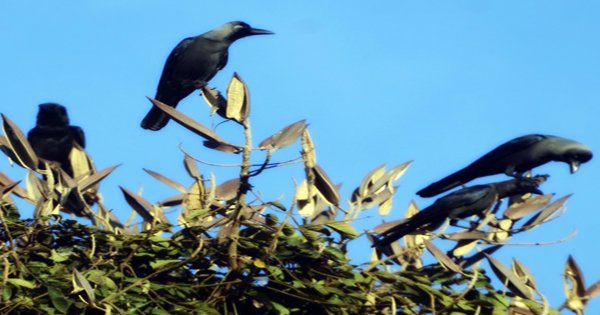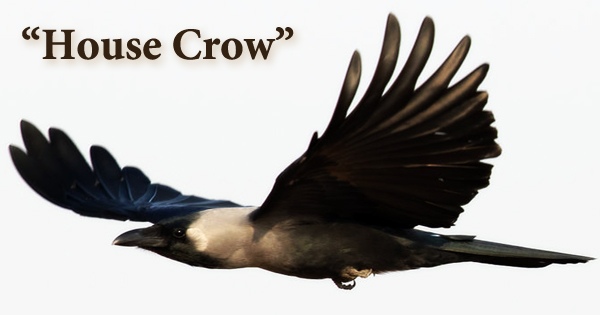The house crow (Corvus splendens), also known as the Indian, greynecked, Ceylon, or Colombo crow, is a smart bird that belongs to a group of animals that are regarded among the world’s most intellectual. It is a common Asian crow that is between the jackdaw and the carrion crow in size (40 cm (16 in) but thinner than either. It has a slender body, long legs, and plumage that is mainly black or blackish-slate in color. Its scientific name means’shining raven,’ alluding to the glossy, jet-black feathers that surround the face, chin, crown, and throat. Males and females have comparable physical characteristics. Juveniles have duller plumage that lacks the glossy black sheen of adults. Corvid species may be distinguished by their size, shape, and geographic location, despite being predominantly or entirely black. However, in certain situations, particularly in Australia, where five or six species coexist, the easiest method to distinguish them is by sound, and the house crow has its own distinct call. The nominate race, C. s. splendens, has a grey neck collar and is found in Pakistan, India, Nepal, and Bangladesh. The subspecies C. s. zugmayeri has a very pale neck collar and is found in the arid areas of South Asia and Iran. C. s. protegatus is a darker grey subspecies found in southern India, the Maldives (often split as maledivicus), and Sri Lanka. C. s. insolens, found in Myanmar, is the darkest form and lacks the grey collar. It has spread to Africa, Europe, the Middle East, and a number of islands, including Mauritius. Around St. Petersburg, Florida, a tiny population has developed. It is a lowland species that may be found in both tropical and subtropical climates. Some have been spotted in Himalayan military bases, though. This bird is closely linked to people who live in cities, towns, and villages. Surprisingly, no communities have been discovered in regions where there are no humans. In Sham Shui Po, New Kowloon, Hong Kong, a colony of 200 to 400 birds has been found, particularly in Lai Kok Estate and Sham Shui Po Park, as well as Kowloon Tsai Park in Kowloon Tsai. Since early September 2010, a person has been spotted in Cork Harbour on Ireland’s south coast. A tiny community of house crows has established themselves in the New World, near St. Petersburg, Florida. Throughout its span, it is linked to human populations, from tiny villages to big cities. In 2001, the population density in Singapore was 190 birds/km2, with measures to reduce the population in the works. This species has multiplied proportionally as a result of a human population expansion in the places it inhabits. Its ability to flourish in such conditions is due to its nature as an omnivorous scavenger.

Male and female house crows are similar in appearance, with the exception that males are somewhat bigger. They have a thin glossy black body, a charcoal grey collar and underparts, and a big black beak. House crows have a reputation for being invasive species that are nearly hard to remove once established due to their behavioral and ecological adaptability, as well as their fabled intellect, which, according to the research, appears to rival or exceed that of humans. The length of the house crow is 42-44cm (body and tail). On the forehead, crown, neck, back, wings, and tail, it has glossy black plumage with a metallic greenish blue-purple shine. The head, neck, and lower breast, on the other hand, are lighter in color (grey tones) and not glossed. The top beak is sharply curled and the bill is black. The eyes are dark brown and the forehead is slanted. Black is the color of the legs and feet. This species has a high degree of resource flexibility and appears to be linked to people, with no populations known to live independently of humans. It is anticipated that it can also persist in several coastal areas of southern and northern Europe, based on niche modeling. A House Crow is a highly clever bird that is always watchful and attentive, strolling or hopping while anxiously flapping its wings. It is a gregarious, diurnal, non-migratory bird that congregates in large flocks and creates huge roosts. Hundreds or thousands of birds may congregate in plantations and mangroves, and this species will also congregate alongside parakeets and mynahs. Just before dawn, house crows return to their feeding areas. It is a very loud species, with a ‘kaaan-kaaan’ or ‘kaa-kaao’ cry that is dry, flat, and toneless. They also emit a variety of quieter, nasal sounds during social encounters. Although house crows may nest on telephone towers, at least some trees in the nearby area appear to be required for effective breeding. In a normal stick nest, it lays 3–5 eggs, although there are sometimes several nests in the same tree. The Asian koel parasitizes them in South Asia. The months of April through July are the busiest for breeding in India and Peninsular Malaysia. For nesting, large trees with large crowns are ideal. House crows consume garbage, leftovers, trash, and sewage, among other things. They also consume lizards, fish, frogs, crabs, insects, nectar, fruits, cereal seeds, eggs, chicks, and small mammals. House crows are common over their vast range and are not considered a globally threatened species. However, colonies of this species have grown to pest proportions in many regions, have spread fast, and are considered invasive. They inflict economic harm by damaging crops and fruit, as well as consuming domestic chicken eggs and chicks. Singapore, Yemen, and a few islands have all attempted to reduce House crow numbers with varying degrees of success. Blood parasites were not found in Tanzanian house crows, despite the fact that several species, such as Trypanosoma corvi, were initially reported in this species. The House crow is common and widespread across its range, according to the IUCN, although no population estimate is known.
















